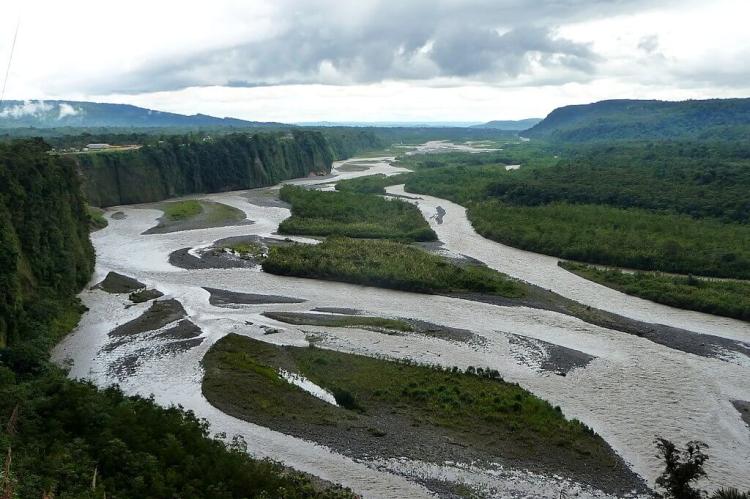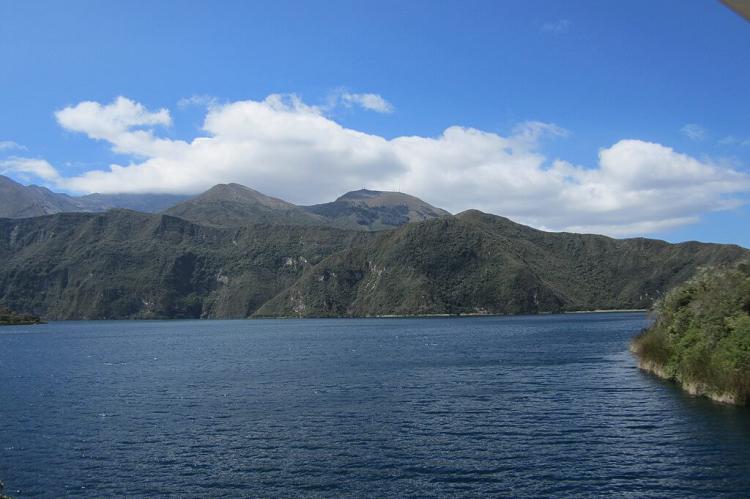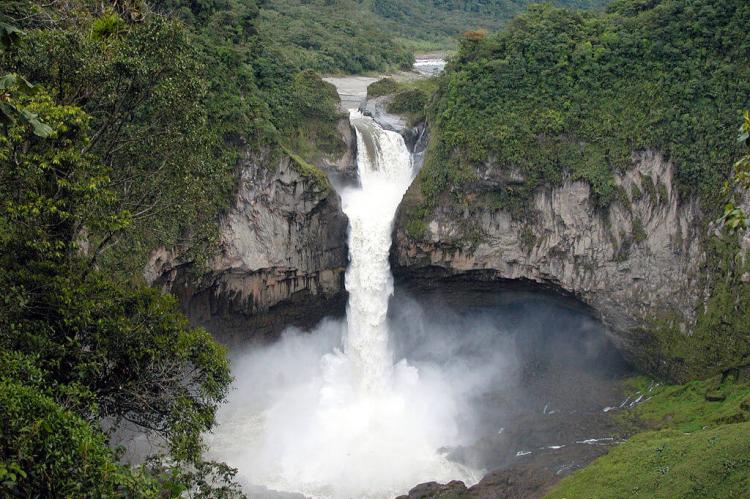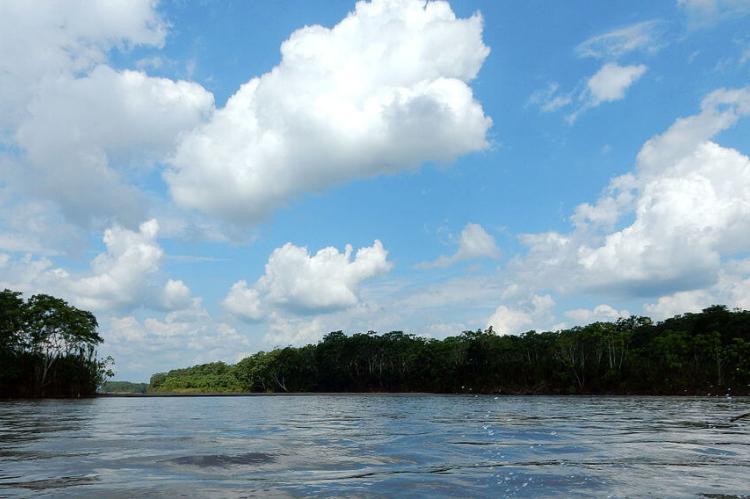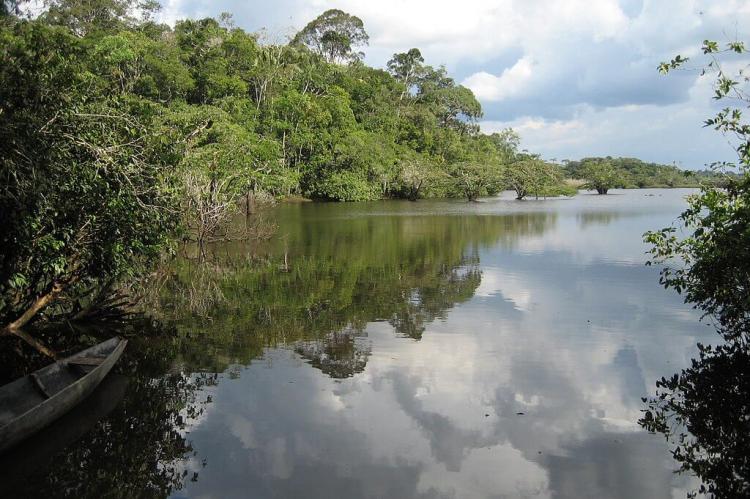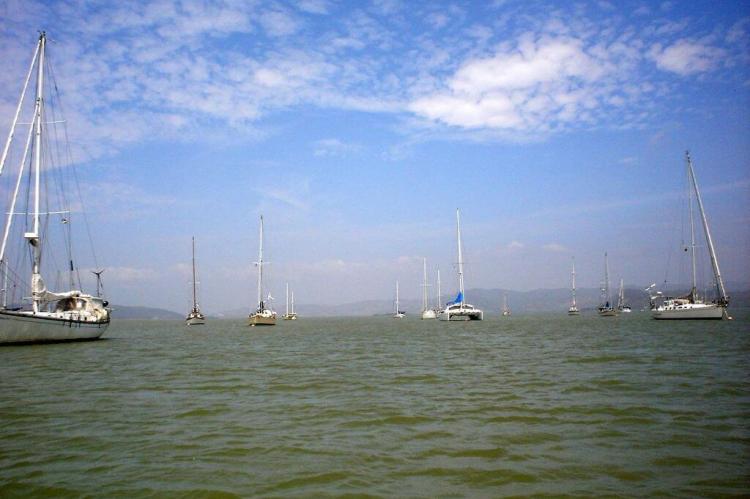Water Bodies of Ecuador
Ecuador is a country in South America home to various water bodies. The Pacific Ocean borders the country to the west. The Amazon River runs through Ecuador, and the country hosts many other rivers, lakes, lagoons, and reservoirs that are essential to the country's natural and cultural heritage.
Water Bodies of Ecuador
Ecuador is a country in South America home to various bodies of water. The Pacific Ocean borders the country to the west. The Amazon River runs through Ecuador, and its water bodies include many lakes, rivers, and waterfalls.
Ecuador's most important river system is the Guayas River, which flows through the country's coastal region. The Guayas River is the longest in Ecuador, an important water source for irrigation and transportation. Other significant rivers in Ecuador include the Napo, Pastaza, and Coca rivers.
Ecuador also has many lakes, including Cuicocha Lake, Laguna de Yahuarcocha, and Laguna Quilotoa. These lakes are all located in the Andes Mountains, and they are popular tourist destinations. Ecuador also has several waterfalls, including the Agoyan waterfall, the country's highest waterfall.
The water bodies of Ecuador are an essential part of the country's natural and cultural heritage. They provide a source of water for drinking, irrigation, and transportation. They are also popular tourist destinations, and they offer a variety of recreational opportunities.
Gulfs and Bays
Ecuador's notable gulfs, bays, and coastal lagoons offer unique natural beauty and recreational opportunities for visitors to enjoy.
Gulf of Guayaquil: Located on the southwestern coast of Ecuador, the Gulf of Guayaquil is a large estuary formed by the Guayas River and the Pacific Ocean. It is a major commercial and shipping hub known for its extensive mangrove forests and diverse marine life. The Gulf of Guayaquil Marine Reserve protects it.
Bay of Caráquez: Situated on Ecuador's central coast, the Bay of Caráquez is a picturesque bay known for its natural beauty and ecological significance. It features mangrove forests, tidal flats, and diverse wildlife. The bay offers opportunities for birdwatching, kayaking, and exploring the surrounding mangrove ecosystem.
Salinas Bay: Located on the Santa Elena Peninsula, Salinas Bay is a popular beach destination known for its sandy beaches and vibrant resort town. It attracts tourists with water activities such as surfing, sailing, and fishing.
Manta Bay: Found in the city of Manta on the central coast, Manta Bay is a significant natural harbor and a busy port. It is known for its picturesque views, fishing industry, and opportunities for boating and sailing.
Esmeraldas Bay: Situated in the city of Esmeraldas on the northwestern coast, Esmeraldas Bay is a large bay known for its beautiful beaches and palm-lined coastline. It offers opportunities for swimming, sunbathing, and exploring the local culture.
Notable Lakes and Lagoons
These are some of Ecuador's notable lakes and lagoons, each offering visitors distinctive natural beauty and recreational opportunities for visitors.
Lake Quilotoa: Situated in the Andes Mountains, Lake Quilotoa is a mesmerizing crater lake known for its brilliant turquoise waters. It is a popular tourist destination and offers opportunities for hiking, horseback riding, and enjoying breathtaking views of the surrounding volcanic landscape.
Lake Cuicocha: Located near Cotacachi in the Imbabura Province, Lake Cuicocha is a volcanic crater lake. It is characterized by its scenic beauty, surrounded by mountains, and offers hiking trails and boat rides for visitors to explore the lake and its two small islands.
Lake San Pablo: Situated in the Imbabura Province, Lake San Pablo is a peaceful lake surrounded by the Andean landscape. It is known for its tranquility and offers activities such as boating, fishing, and enjoying the serene ambiance of the area.
Limpiopungo Lagoon: Found in Cotopaxi National Park, the Limpiopungo Lagoon is a picturesque lake located at the base of the Cotopaxi volcano. It offers stunning views of the volcano and the surrounding landscapes. Visitors can enjoy hiking trails around the lake and spot various bird species.
El Cajas National Park Lakes: Located near the city of Cuenca, El Cajas National Park is home to several lakes. The park's glacial lakes, including Llaviuco, La Toreadora, and Taitachungo, offer crystal-clear waters and beautiful landscapes. They provide opportunities for hiking, camping, fishing, and wildlife observation.
Chalupas Lakes: Situated in the Loja Province within the Podocarpus National Park, the Chalupas Lakes are a group of small lakes surrounded by cloud forests and páramo vegetation. They offer a unique high-altitude ecosystem and opportunities for birdwatching, hiking, and exploring the pristine natural surroundings.
Yambo Lagoon: Located in the Tungurahua Province, the Yambo Lagoon is a scenic lake surrounded by mountains and lush vegetation. It is known for its tranquility and provides boating, fishing, and picnicking opportunities.
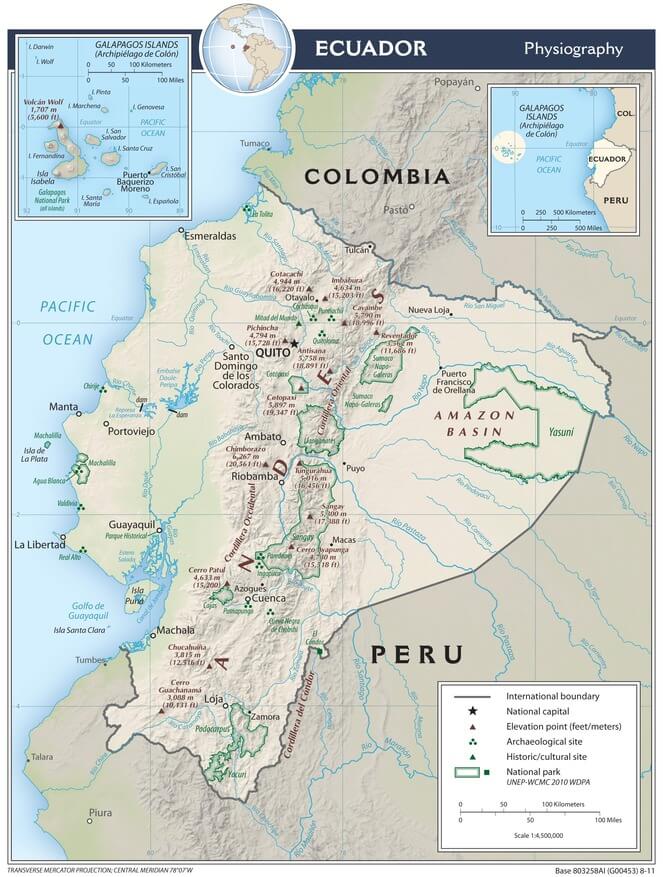
Ecuador physiographic map.
Notable Dams and Reservoirs
These are some of Ecuador's notable dams and reservoirs, each playing a significant role in hydroelectric power generation, and water management, and supporting various sectors of the country's economy.
Coca Codo Sinclair Dam: Located in the Napo Province, the Coca Codo Sinclair Dam is one of the most significant hydroelectric projects in Ecuador. The dam harnesses the power of the Coca River and creates a vast reservoir known as the Coca Codo Sinclair Reservoir. It generates significant electricity for the country and contributes to Ecuador's energy production.
Paute Dam: Situated in the Azuay Province, the Paute Dam is another major hydroelectric project in Ecuador. It is built on the Paute River and creates the Paute Reservoir. The dam plays a crucial role in Ecuador's energy generation and provides water for irrigation purposes.
Agoyán Dam: Located on the Pastaza River in the Tungurahua Province, the Agoyán Dam is primarily used for hydroelectric power generation. It forms the Agoyán Reservoir, which offers scenic views and recreational activities such as fishing and boating.
Daule Peripa Dam: Found in the Guayas and Manabí provinces, the Daule Peripa Dam is constructed on the Daule River. It creates the Daule Peripa Reservoir, which serves multiple purposes, including irrigation, drinking water supply, and flood control.
Baba Dam: Situated on the Guayas River in the Guayas Province, the Baba Dam is a multipurpose project. It provides water for irrigation, helps regulate the river flow, and supplies water to nearby communities.
Chongón Dam: Located in the Guayas Province, the Chongón Dam is constructed on the Chongón River. It forms the Chongón Reservoir, which supplies water for various purposes, including agriculture and drinking water.
La Esperanza Dam: Found in the Los Ríos Province, the La Esperanza Dam is built on the Quevedo River. It creates the La Esperanza Reservoir, which serves as a water source for agricultural activities and supplies drinking water to nearby communities.
Notable Rivers
These are some of the notable rivers in Ecuador, each with its significance in ecology, transportation, and the livelihoods of local communities.
Amazon River: The Amazon River is the largest in Ecuador and one of the world's longest and most voluminous rivers. It originates in the Andes Mountains and flows eastward through the eastern region of Ecuador, forming part of the border with Peru. The Amazon River and its tributaries sustain a rich and diverse ecosystem, supporting the Amazon rainforest and providing habitats for countless species of plants and animals.
Napo River: Originating in the Andes Mountains, the Napo River is a major tributary of the Amazon River. It flows through the eastern region of Ecuador, passing through lush tropical rainforests and connecting numerous indigenous communities. The Napo River is an important transportation route supporting local economies through fishing, agriculture, and ecotourism.
Guayas River: The Guayas River is the most important in western Ecuador. It originates in the Andes Mountains and flows westward, passing through the city of Guayaquil before reaching the Gulf of Guayaquil. The river is vital in transportation and commerce, serving as a trade route for agricultural products and connecting inland regions to the coast.
Pastaza River: Originating in the Ecuadorian Andes, the Pastaza River is a major tributary of the Amazon River. It flows through the central region of Ecuador, traversing diverse landscapes, including mountains, rainforests, and the Pastaza Canyon. The Pastaza River is renowned for its whitewater rafting opportunities and its importance in supporting local communities and ecosystems.
Santiago River: Located in northern Ecuador, the Santiago River flows through the province of Esmeraldas. It is known for its scenic beauty and provides water for irrigation and agricultural activities in the region.
Jubones River: Situated in southern Ecuador, the Jubones River originates in the Andes Mountains and flows towards the Pacific Ocean. It passes through the provinces of Azuay and El Oro, providing water for agriculture and serving as a source of hydroelectric power.
Coca River: The Coca River is a tributary of the Napo River and originates in the Andes Mountains. It is known for its fast-flowing waters and scenic beauty. The Coca River is integral to hydroelectric power generation and provides adventure activities like kayaking and rafting opportunities.
Babahoyo River: Flowing through the central part of Ecuador, the Babahoyo River is a major tributary of the Guayas River. It passes through the provinces of Los Ríos and Guayas and plays a significant role in agriculture, irrigation, and transportation.
Zamora River: Located in southern Ecuador, the Zamora River is a tributary of the Santiago River. It flows through the province of Zamora Chinchipe and is known for its scenic beauty and contribution to the region's hydroelectric power generation.
